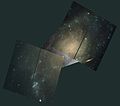| Revision as of 10:41, 27 June 2016 editJ 1982 (talk | contribs)Autopatrolled, Extended confirmed users153,041 edits destub← Previous edit | Revision as of 23:05, 20 July 2016 edit undoTelecineguy (talk | contribs)Extended confirmed users52,794 editsm ref CaltechNext edit → | ||
| Line 21: | Line 21: | ||
| }} | }} | ||
| '''NGC 45''' is a ] ]<ref>http://simbak.cfa.harvard.edu/simbad/sim-id?Ident=ngc+45</ref> in the constellation of ]. It was discovered on 11 November 1835 by the English astronomer ]. In the sky, it is located near the magnitude 6.8 star HD 941. | '''NGC 45''' is a ] ]<ref>http://simbak.cfa.harvard.edu/simbad/sim-id?Ident=ngc+45</ref> in the constellation of ]. It was discovered on 11 November 1835 by the English astronomer ]. In the sky, it is located near the magnitude 6.8 star HD 941. | ||
| NGC 45 has no clear defined spiral arms like the ] galaxy. Unlike the Milky Way, the ] is also very small and distorted. NGC 45 thus does not have a ] like the Milky Way.<ref></ref><ref name=gowanlock-2011>{{Cite journal | last1 = Gowanlock | first1 = M. G. | last2 = Patton | first2 = D. R. | last3 = McConnell | first3 = S. M. | doi = 10.1089/ast.2010.0555 | title = A Model of Habitability Within the Milky Way Galaxy | journal = Astrobiology | volume = 11 | issue = 9 | pages = 855–873 | year = 2011 | pmid = 22059554| pmc = |arxiv = 1107.1286 |bibcode = 2011AsBio..11..855G }}</ref> <ref name="SP-20150821">{{cite web |last=Choi |first=Charles Q. |title=Giant Galaxies May Be Better Cradles for Habitable Planets |url=http://www.space.com/30335-giant-galaxies-habitable-planets.html |date=21 August 2015 |work=] |accessdate=24 August 2015 }}</ref> For the Milky Way, the galactic habitable zone is commonly believed to be an ] with an outer radius of about 10 ]s and an inner radius close to the ], both of which lack hard boundaries.<ref name=gowanlock-2011 /> | |||
| ==Gallery== | ==Gallery== | ||
Revision as of 23:05, 20 July 2016
| NGC 45 | |
|---|---|
 NGC 45 by GALEX (ultraviolet) NGC 45 by GALEX (ultraviolet) | |
| Observation data (2000.0 epoch) | |
| Constellation | Cetus |
| Right ascension | 00 14 3.99 |
| Declination | −23° 10′ 55.5″ |
| Redshift | 0.001558 |
| Heliocentric radial velocity | 467 km/s |
| Distance | 32.6 ± 10 Mly (10 ± 3.1 Mpc) |
| Apparent magnitude (V) | 10.4 |
| Characteristics | |
| Type | SA(s)dm |
| Apparent size (V) | 7.41′ × 5.13' |
| Other designations | |
| UGC 4, MCG 04-01-21, PGC 930 | |
NGC 45 is a low surface brightness spiral galaxy in the constellation of Cetus. It was discovered on 11 November 1835 by the English astronomer John Herschel. In the sky, it is located near the magnitude 6.8 star HD 941.
NGC 45 has no clear defined spiral arms like the Milky Way galaxy. Unlike the Milky Way, the center bar nucleus is also very small and distorted. NGC 45 thus does not have a galactic habitable zone like the Milky Way. For the Milky Way, the galactic habitable zone is commonly believed to be an annulus with an outer radius of about 10 kiloparsecs and an inner radius close to the Galactic Center, both of which lack hard boundaries.
Gallery
References
- ^ NASA NED, "NGC 0045" (accessed 20 April 2010)
- "Distance Results for NGC 0045". NASA/IPAC Extragalactic Database. Retrieved 4 May 2010.
- http://simbak.cfa.harvard.edu/simbad/sim-id?Ident=ngc+45
- Caltech, II. MORPHOLOGY, #34
- ^ Gowanlock, M. G.; Patton, D. R.; McConnell, S. M. (2011). "A Model of Habitability Within the Milky Way Galaxy". Astrobiology. 11 (9): 855–873. arXiv:1107.1286. Bibcode:2011AsBio..11..855G. doi:10.1089/ast.2010.0555. PMID 22059554.
- Choi, Charles Q. (21 August 2015). "Giant Galaxies May Be Better Cradles for Habitable Planets". Space.com. Retrieved 24 August 2015.
External links
- NGC 45 on WikiSky: DSS2, SDSS, GALEX, IRAS, Hydrogen α, X-Ray, Astrophoto, Sky Map, Articles and images
| Astronomical catalogs | |
|---|---|
| NGC | |
| PGC | |
| UGC | |

